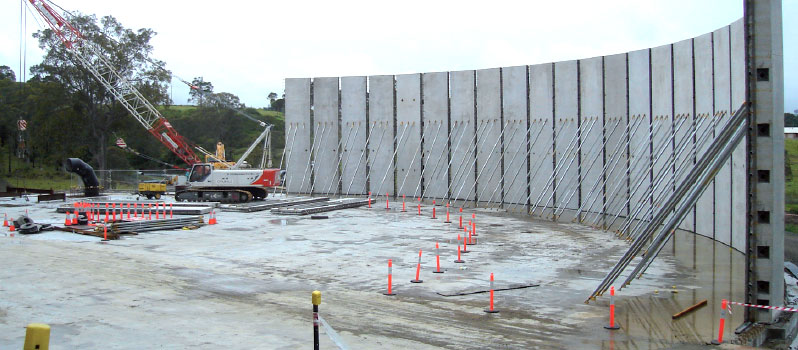
Civilbuild has just completed construction of one of the biggest concrete water tanks in Australia, built for Hunter Water at Dungog.
The scope of the project can, perhaps, be judged by statistics for the pouring of the base.
- The floor of the tank is 65 metres in diameter
- It involved the pouring of 622 cubic metres of concrete in one operation
- 35 men worked over eight hours to complete the pour
- They were so hungry at the finish they demolished 50 steaks and 200 sausages.
Once the base of the tank was completed 72 pre-cast panels, each weighing 17 tonnes and manufactured at Civilbuild’s pre-cast yard at Redhead, were lifted into place with the company’s 70 tonne crawler crane, then propped. Once all the panels were in place they were post tensioned with steel strands inserted into preformed ducting, an operation similar to the hoops placed around wine barrels.
Civilbuild worked on this project as a sub contractor to A J Lucas. The decision to build the panels at the pre-cast yard and transport them to the site had several advantages to casting them on site.
It was known that casting the panels would take about two months so work started on them while the site for the tank was being prepared and the floor poured.
This avoided the need for an extensive storage area on site and meant a controlled flow of panels once they were required.
Another of the most important advantages was better quality control with the best example of this being the controlled supply of ready mix concrete The concrete batching plant at Redhead is 300 metres from the moulds. The nearest batching plant to the Dungog site was 40kms away, resulting in a small amount of time to discharge and place the partially hardened concrete.
Civilbuild cast the 10 metre long panels, each over 2.35 metres of arc width, in a purpose made curved steel mould designed in house, fabricated off site and set up in the yard by
Civilbuild’s boilermakers.
The use of a steel mould provided a better finish compared to the use of timber formwork and stack casting which would have been necessary if the panels had been made on site. The advantage of less site labour working at heights, quality assurance and safety improvements is one of the reasons for the growth of the pre-cast industry.
Civilbuild’s managing director, Steve Wood, said more and more projects Civilbuild undertook provided the opportunity, often at the client’s request, the option of producing pre-cast
concrete items off site.
“These are items that, traditionally, would have been cast in-situ,” Steve Wood said.
“We are only limited by the size and weight of pre-cast products that low loaders and cranes can handle.
“Given that low loaders can readily carry up to 100 tonnes and cranes can lift up to 300 tonnes capacity the opportunities to pre-cast more and more off site are promising.”

